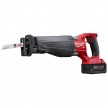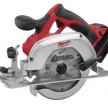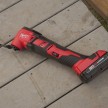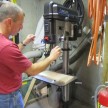Best Cordless 9-10″ Cut-Off Saw 2025
Best Battery Powered 9-10″ Concrete Cutter | Head-To-Head Test
A Cut-Off Saw—also known as a power cutter, masonry saw, or demo saw—is a handheld tool commonly used by landscape masons and contractors for tough cutting tasks. Designed to handle hard materials, it’s ideal for cutting pavers, bricks, concrete blocks, rebar, and metal pipe.
Typical applications include cutting pavers for patios or walkways, trimming pavers for precise fits, and cutting through steel pipe, I-beams, or rebar on construction sites. We all recognize that battery-powered saws require less maintenance, are easier to start, and forgo the need for the 50:1 fuel mixture.
Our industry is now experiencing an increased focus on the integration of battery-operated equipment across the job site, driving the discussio n of gas
n of gas
tools vs. battery-powered tools. For us to even have this conversation, we need to agree that battery tools need to compete with gas in performance, power, and run-time.
We decided to perform a Head-to-Head test on 8 cordless concrete cutters (cut-off saws) to determine which one was the best saw.
Cordless Cut-Off Saw | Line-Up
Eight manufacturers sent their cordless cut-off saws and saw blades.
Atlas
Model: 59660
Volts: 80v
Watt Hours: 288 Wh
Wheel Size: 9″
Max Cutting Depth: 3.25″
Max RPMs: 6500
Arbor Size: 7/8″
Tool Weight w/ Battery: 17.11 Lbs
Bosch
Model: GCS18V-230N
Volts: 18v
Wheel Size: 9″
Max Cutting Depth: 3.3″
Max RPMs: 6200
Arbor Size: 7/8″
Tool Weight w/ Battery: 15.15 Lbs
DEWALT
Model: DCS692
Volts: 60v
Wheel Size: 7/8″
Max Cutting Depth: 3.25″
Max RPMs: 6600
Arbor Size: 7/8″
Tool Weight w/ Battery: 16.0 Lbs
Evolution
Model: R10DCT-Li
Volts: 40v
Wheel Size: 10″
Max Cutting Depth: 4.0″
Max RPMs: 5000
Arbor Size: 7/8″
Tool Weight w/ Battery: 19.25 Lbs
Husqvarna
Model: K540i
Volts: 40v
Wheel Size: 10″
Max Cutting Depth: 3.94″
Max RPMs: 6450
Arbor Size: 1″
Tool Weight w/ Battery: 15.45 Lbs
Makita
Model: GEC03T
Volts: 40V
Wheel Size: 9″
Max Cutting Depth: 3.5″
Max RPMs: 6600
Arbor Size: 7/8″
Tool Weight w/ Battery: 16.1 Lbs
Milwaukee
Model: 2786-20
Volts: 18v
Wheel Size: 9″
Max Cutting Depth: 3.4″
Max RPMs: 6600
Arbor Size: 7/8″
Tool Weight w/ Battery: 14.14 Lbs
Stihl
Model: TSA230
Volts: 36v
Wheel Size: 9″
Max Cutting Depth: 2.75″
Max RPMs: 5000
Arbor Size: 7/8″
Tool Weight w/ Battery: 14.20 Lbs
Our Testing Criteria
Our team scored the cordless cut-off saws on eight criteria, each ranked independently, and combined them to determine the “Overall Best Power Cutter.” We include but did not rank the “Best Value” category, but list them for informational purposes. We also did NOT include decibel testing since all of these saws are well over the OSHA rating for hearing protection.
 Scoring Criteria – Cordless Cut-Off Saws
Scoring Criteria – Cordless Cut-Off Saws
- Runtime Test – Most lineal feet cut in 3” concrete [Ave Speed]
- Rebar Cutting Test – Fastest cutter of five ganged #4 rebar. [Ave. speed]
- Watt-hour per cut – we include this for your reference
- Depth of Cut – Saws were ranks for cut capacity
- Ergonomics – Ergonomics is important to users considering any power tool purchase.
- Features – We discuss stand-out features and team favorites
- Weight – Weight can get cumbersome. We weighed each concrete cutter as tested (with Batteries)
- Best Power Cutter
- Best Value
- Price – at the time of publishing
 Runtime Test | Concrete Preparation
Runtime Test | Concrete Preparation
We poured a [3”deep x 44” long] 3500 psi slab and allowed it to cure for 30 days.
The concrete cutters were all outfitted with a fresh battery and manufacturer specific concrete or multi-material blade.
All of the manufacturers insisted on us using their branded blades, claiming that the blades were designed and optimized for the saw.
Run-time Test Procedure:
Without a test rig to eliminate these types of variables, it is very hard to have a controlled test. Technique is important and we recognize that we needed to let the tool do the work and not bog it down, which is why we designed our tests with the following procedures:
- All of the battery saws had fresh batteries and new Manufacturer blades.
- Water was used on each cut.
- Every operator employed a “stepped” cutting method.
- Every operator let the tool do the cutting and listened to the motor for feedback. Operators applied pressure when the tool would allow it, and if the motor seemed to be bogging down, they let up on the pressure
- The test ended when the saw battery was depleted or the tool shut down.
- The total 3’x44’ cuts [including partial cuts] were recorded for a total lineal foot measurement.
Note on Step Cutting
Step Cutting, also known as incremental cutting, involves making multiple incremental cuts with the saw until the overall desired depth of cut is reached. Step cutting optimizes cutting efficiency, improves blade life and results in straighter cut lines.
 Run-Time Testing | Winner Evolution
Run-Time Testing | Winner Evolution
The newcomer Evolution was a runaway winner with a total of 282-inches cut. This distance is a staggering 50% more than the 2nd placed saw. Second place went to the Atlas saw at 188-inches, followed in third by the Husqvarna with 150-inches.
The test yielded two unexpected results: The Dewalt cut 74-inches and experienced an automatic shutdown with 2-bars left on the battery. The Makita unfortunately was only able to cut 58-inches.
To ensure repeatability, we performed a second test on these two tools, with different, charged batteries, and users, resulting in the same result.
 Runtime-Testing | Watt-Hours Per Cut | Winner Evolution
Runtime-Testing | Watt-Hours Per Cut | Winner Evolution
Whenever we run a true runtime test on a cordless platform there is always a big elephant in the room regarding the battery size. Cordless tools these days run on a variety of voltage between 12-80V and even sometimes 120 V. Every tool manufacturer will market and advertise the Amp Hour rating of the battery. This is useful when comparing tools on the same platform or tools across platforms that share the the same nominal voltage.
However with all the tools running at different voltages, the quickest way to get a snapshot of how big a “gas tank” the tool has is to see how many Watt-Hours the batteries on board have. We can then take that Watt-Hour rating of each tools battery and calculate an “Inches Cut per Watt-Hour” to even the playing field and determine which tool is the most efficient at transforming the battery energy in cutting performance.
The winner of the normalized runtime test was Evolution with an Inches Cut per Watt-Hour of 0.98. We recognize that these values are unique to this test but eh important take away is the relative performance from saw to saw. This is especially relevant when the next closest saw was the Atlas with an Inches Cut/Wh of 0.65. Third place was Milwaukee at .61.
Rebar Cutting | Procedure
This test was designed to measure and evaluate the average time to cut through a bundle of five #4 rebar, a common cutting operation seen on jobsites.
In construction, #4 rebar is one of the most popular sizes, and a versatile choice for various concrete structures like slabs and columns.
All the saws were outfitted with an abrasive blade, and a single operator performed all five cuts on each saw.The operator pushed as hard as the saw would allow. The operator used the same technique for each cut to maintain uniformity. Each cut was timed separately, the combined times were then averaged and scored.
Fastest Rebar Cutting | Winner – Atlas
The Atlas tool outperformed all others in this test, achieving the fastest average cutting time of 7.56 seconds per cut. However, it’s worth noting that while we did not record decibel levels for these tools, the Atlas produces a high-pitched sound when operating, which can be quite uncomfortable for your ears.
DeWalt followed closely behind with 8.24 seconds. Evolution delivered third place performance with 12.52 seconds, while Husqvarna and Bosch lagged significantly. Bosch being the slowest at 25.31 seconds on average
Evolution does not recommend using an abrasive blade on their power cutter due to the smaller size of the blade flange. Instead, they suggest using their multi-material diamond blade.
Speed Test | Cutting Pavers Procedure
We conducted 5 cuts on 1×12 pavers to measure cutting time. Fresh batteries were used, and the test was performed by a single operator. Water and step-cutting techniques were applied during the cuts
 Speed Test | Winner – Makita
Speed Test | Winner – Makita
In a 4-way, photo finish Makita took first place with an average time of 8.4 seconds.
Evolution came in next with 8.6 seconds, followed by Husqvarna with 8.7 seconds and Milwaukee with 8.9 seconds.
On the other end of the spectrum was Bosch and Stihl with 14+ seconds.
 Depth Of Cut | Winner – Evolution
Depth Of Cut | Winner – Evolution
The 9- and 10-inch saw category is primarily designed for cutting pavers and metal. Generally, a larger blade allows for a greater cutting depth—but there’s notable variation between models.
As expected, the two saws with 10-inch blades delivered the deepest cuts. Evolution leads the pack with a 4-inch cutting depth, followed closely by Husqvarna at 3.94 inches.
In third place is Makita, offering a 3.5-inch cutting depth. Stihl comes in last with the smallest capacity at 2.75 inches.
 Power Cutter Ergonomics | Winner – Makita
Power Cutter Ergonomics | Winner – Makita
The ergonomics evaluation in this section is purely subjective, and based on the opinions of the testing crew. After a full day of running performance tests, the team sat down and ranked each tool in several categories on a score of 1-5 [5 being the best].
For the ergonomics evaluation, the team evaluated the following criteria:
1. Grip
2. Balance
3. Line of sight
4. Vibration
5. Blade change
6. Battery change

Makita came out on top with a total of 24 points, excelling particularly in line of sight and balance. Both Evolution and Stihl tied with 23 points. Evolution earned high marks for its grip ergonomics and vibration control, while Stihl stood out in the balance category, likely due to its lightweight and compact design. Stihl also led the group in ease of battery change.
Power Cutter Features | Winner – Evolution
The Evolution is a feature-rich tool and the only saw in the test equipped with a dual LED light, base wheels, and a solenoid activated by the tool’s trigger. It was a clear feature winner in our testing. The Evolution features a separate power switch to control the water, and from that point onward, the trigger regulates the flow. Its battery compartment is easy to open, with a spring-loaded lid that locks automatically for secure storage.
Milwaukee ranked second for its AP connectivity, blade guard, and blade brake, while Husqvarna came in third, noted for its user interface, anti-kickback system, and trigger activation.
As the newest saw on the market, one would expect Evolution to have ironed out the kinks. With ample time to study user pain points, it’s clear they’ve made efforts to address and improve on them.
If I had to offer them feedback for improvement I’d suggest eliminating the left-sided safety switch and use an ambidextrous trigger spring lever instead. Left handed users will thank you!. Additionally I’d love to see this tool offered as a single battery tool with a higher ah battery. Having to carry multiple batteries and a large dual charger can be cumbersome.
Summary of Key Features
We took the time to list some of the key features on these tools so you can better understand their build quality, even if they didn’t rank top 3.
 Battery Compartment
Battery Compartment
Evolution has two batteries and requires users to place the tool down and hold the spring-loaded lid open. Evolution features a spring-loaded battery lid that automatically closes and latches securely.
The team noted that the DeWalt lever could be conveniently operated while gripping the support handle, even with gloves, but could also be accidentally opened while using.
Milwaukee and Atlas both have lids covering their batteries. Atlas uses an external plastic latch that the team felt might easily break, while Milwaukee’s design is flush with the housing, offering better protection.
Husqvarna, Makita, and Stihl all have exposed batteries. The team expressed concerns about cleaning “slurry splatter” from these exposed areas.
Additionally, while we acknowledge that these batteries are IP-rated and sealed, a few of the tools lack drain ports in their battery compartments, which could potentially lead to issues for users. These include Atlas, Bosch, Dewalt, Makita, and Stihl.
 Blade Guard
Blade Guard
The team preferred the one-handed guard adjustment on Evolution, Husqvarna, Milwaukee, and Makita over the dual-activation guard found on Stihl, Bosch, and DeWalt. Stihl’s guard is fixed and offers no adjustment, which was a drawback.
Blade Brake
All models tested include blade brakes. The slowest stop time was recorded on the Stihl, at 3.4 seconds.
 User Interface
User Interface
All tools include indicator lights that alert the user to aggressive cutting or overheating. While some brands use multi-colored flashing lights, none were considered highly intuitive (except for basic cues like green, yellow and red indicating issues). Bosch, DeWalt, and Makita have indicator lights, but they are often obscured by the user’s hand during operation.
Husqvarna features a digital display panel that shows battery level, Bluetooth connectivity, temperature, and XHalt (kickback protection) status.
LED Worklight
Bosch, Evolution, and Makita include LED work lights. Evolution and Makita have dedicated switches to turn the lights on or off. Evolution stands out with dual high-intensity lights, positioned on either side of the blade.
 App Connectivity
App Connectivity
Husqvarna and Milwaukee offer app connectivity for performance monitoring.
Husqvarna’s Bluetooth app provides access to manuals, service history, parts info, and runtime data.
Milwaukee’s One-Key app adds tool lockout and tracking features. Stihl offers a battery monitoring app. DeWalt includes hardware for a Bluetooth tag, but the tag itself is not included.
 Anti-Kickback
Anti-Kickback
Husqvarna includes the XHalt feature, a kickback protection system that shuts the tool off immediately and requires a restart for continued use.
 Spindle Lock
Spindle Lock
Bosch, Evolution, Makita, and Stihl all offer easy-to-use spindle locks. Bosch uses a cam-style lever, while the others use push-button locks. Atlas and DeWalt also use push buttons, but the team found them less convenient.
Husqvarna and Milwaukee require inserting a tool to lock the spindle and using a second tool (scrench) to remove the blade nut—this method was least favored by the team.
Water System
The Evolution is the only saw in the test to use a solenoid activated by the tools trigger.
All tested models include dual-sided water feeds, except for Stihl, which has only one. Most tools have water valves located on the bottom; however, Husqvarna’s valve is positioned on the top support handle. The team felt this location might be prone to damage during transport, but is more convenient to operate.
Bosch, DeWalt, and Stihl route their hoses internally, which helps prevent external snags and hang-ups.
NOTE:
Many of these saws has a MAX psi rating which is below what you might find in jobsite. For example the Stihl has a MAX 25 psi, and Milwaukee 55 psi, in contrast the evolution has a 145 MAX psi.
The municipal water at our testing site was 91 psi and we were required to use a pressure reducer [$7.00 on Amazon]
Trigger Mechanism
With regard to trigger operation, the team preferred saws that required the fewest steps to activate. The top performers were those equipped with a small, spring-activated, safety lever, integrated into the trigger. This design was found to be quick, easy to use, and ambidextrous, offering both safety and efficiency without adding unnecessary complexity.
Base Shoe
When evaluating the bottom guards of the cordless concrete cutters, the team focused on durability, material quality, and how well each design supported pivoting into cuts. Atlas, Bosch, Dewalt, Stihl, and Evolution stood out for their robust metal construction.
Stihl’s metal brace was especially notable for being durable, easy to service, and replaceable, earning it top marks. Evolution took a unique approach with a wheeled metal skid plate, which not only acted as a bottom guard but also improved accuracy for long, straight cuts and may help reduce user fatigue.
Husqvarna did not include a full bottom guard. Instead, it used partial metal clips and rubberized feet, which offered less protection and durability—especially during rugged use or transport.
 Makita used a PVC-like plastic brace. While functional for occasional fulcrum pivoting, the team expressed concerns about its long-term durability under continuous job site use. Milwaukee also used a plastic brace and, although not designed to be dragged, the team believed it would likely experience wear quickly in real-world scenarios.
Makita used a PVC-like plastic brace. While functional for occasional fulcrum pivoting, the team expressed concerns about its long-term durability under continuous job site use. Milwaukee also used a plastic brace and, although not designed to be dragged, the team believed it would likely experience wear quickly in real-world scenarios.
Overall, saws with metal bottom guards provided better performance and longevity, while plastic or minimal designs presented potential issues over time.
 Wrench Storage
Wrench Storage
Four saws stood out for their well-designed wrench storage: Atlas, Bosch, Evolution, and Milwaukee. Three of these tools store a flat wrench in a dedicated slotted compartment beneath the trigger handle, while Milwaukee uses that same location to store a scrench. Because Milwaukee requires two tools for blade changes, it also includes a hex wrench stored in the side of the handle.
DeWalt stores its wrench inside the battery compartment. While the team felt this was the most secure storage option, it may interfere with fingers or knuckles during battery removal.
 Husqvarna and Makita both store their scrench in a clip mounted to the support handle. The team found this location convenient but more prone to loss during transport or heavy use. Stihl does not offer on-board wrench storage, which was seen as a drawback for convenience.
Husqvarna and Makita both store their scrench in a clip mounted to the support handle. The team found this location convenient but more prone to loss during transport or heavy use. Stihl does not offer on-board wrench storage, which was seen as a drawback for convenience.
Power Cutter Weight | Winner – Milwaukee
We weighed each tool with the battery tested. Milwaukee tipped the scales at 14.14 lbs, Stihl was 14.20 lbs a the next lighter was Bosch at 15.5 lbs. The heaviest saw was the Evolution at 19.25 lbs.
Power Cutter | Cost
Many users are loyal to a battery platform, others by cost. We looked at bare tool pricing. The best priced power cutter is the Atlas, which is only sold as a kit and cost $ 399.00. Evolution is second at $450.00, and the STIHL at $550. The most expensive bare tool is the Husqvarna at $671.00.
The following are purchase links for the saw as bare tools, except ATLAS, which sells as a kit only.
Power Cutter Purchase Links
ATLAS – 80v 9″ Cordless Concrete Cut-off Saw Kit
Bosch – 18v 9″ Cordless Concrete Cut-off Saw – Bare Tool
DEWALT – 60v 9″ Cordless Concrete Cut-off Saw – Bare Tool
Evolution – 40v 10″ Cordless Concrete Cut-off Saw – Bare Tool
Husqvarna – 40v 10″ Cordless Concrete Cut-off Saw – Bare Tool
Makita – 40v 9″ Cordless Concrete Cut-off Saw – Bare Tool
Milwaukee – 18v 9″ Cordless Concrete Cut-off Saw – Bare Tool
STIHL – 36v 9″ Cordless Concrete Cut-off Saw – Bare Tool
 Best Power Cutter | Winner – Evolution
Best Power Cutter | Winner – Evolution
Evolution ran away with first place, averaging between first and second place in every category. Its worst showing was third place in the rebar cutting test. It scored 11 total points.
 The next closest saw in this test was the Atlas with 27-points. It was the fastest in our rebar cutting test and second place in both slab cutting categories. Third was the Husqvarna with 28-points.
The next closest saw in this test was the Atlas with 27-points. It was the fastest in our rebar cutting test and second place in both slab cutting categories. Third was the Husqvarna with 28-points.
Note: Given the number of categories scored for our overall ranking we decided to double the value of our performance tests.
Both the Concrete Endurance and Rebar Speed scores were multiplied by a factor of 2 in the final chart. We feel that the cutting endurance and cutting power of these tools carry the most weight and importance to the potential end user.
 So Who Is Evolution?
So Who Is Evolution?
Evolution is a company that has built a strong reputation in the industrial power tool sector over the past 30 years. Initially, they focused on steel dry-cutting technology and were pioneers in developing TCT (Tungsten Carbide Tipped) saws specifically designed for cutting steel. This innovation was a major step forward in the industry, making it easier to cut through tougher materials with greater precision.
As the company grew, it expanded its product lineup to cater to a broader range of users, from professionals to DIY enthusiasts. They now offer a variety of multipurpose tools that can handle wood, aluminium, and steel. More recently, Evolution has embraced the trend of cordless tools, making it even more convenient for users who need flexibility in their work, whether they’re on a job site or working in a more mobile setting.
Their emphasis on durability, versatility, and quality has made Evolution a go-to brand for many in the industrial and DIY tool markets.
 Best Value Power Cutter | Winner – Atlas
Best Value Power Cutter | Winner – Atlas
These saws are undoubtedly pricey tools, and the best value is typically awarded to the saw that performs well while being priced lower than its competitors.
The Atlas was the only tool not sold as a bare tool, yet it still came in at a lower price point than the others. It also performed second-best in our testing. We’ve been increasingly impressed with Harbor Freight’s Bauer and Atlas tools lately. However, it’s still too early to determine if these newcomers will prove as durable as the time-tested brands.
 Closing Thoughts
Closing Thoughts
The biggest issue with cordless cut-off saws is charge time, and having the power in the field to charge. It’s our opinion that contractors who cut concrete with 2 tanks of gas or less a day are in the “sweet-spot” to convert to a battery power cutter.
If you are cutting all day and using 5 to 7 tanks of gas you should stay with a gas cutter or invest in more batteries.
We get lots of comments about how we make the final rankings. There are dozens of ways to compare tools, our goal when testing is to achieve repeatable, consistent results. We share ALL the data from our tests, so you can re-rank the tools however you want. If you don’t care about an item, we ranked – no problem. Remove that from the matrix above and re-rank them.
Hopefully you’ll find this comparison test useful when considering purchasing a 9 or10-inch cordless power cutter.





































